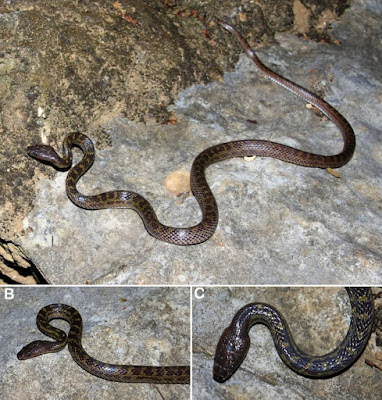 |
| Lycodon banksi
Luu, Bonkowski, Nguyen, Le, Calame & Ziegler, 2018
|
Abstract
We describe a new species of the genus Lycodon Boie based on an adult male specimen from Khammouane Province, central Laos. Lycodon banksi sp. nov. is distinguished from its congeners by a combination of the following characters: (1) SVL 415 mm; (2) dorsal scales in 17–17–15 rows, dorsal scales on the anterior 2/3 of the body length smooth, the six central dorsal scale rows of the posterior 1/3 of the body length feebly keeled; (3) supralabials 8; (4) infralabials 10; (5) loreal in contact with the eye; (6) cloacal single; (7) ventral scales 241; (8) subcaudals 26+, paired (tail tip lost); (9) dorsal surface of body with 87 greyish yellow blotches; (10) dorsal surface of tail with 11+ light bands (tail tip lost); (11) ventral surface of body and tail uniformly grey cream. Based on the molecular comparisons, Lycodon banksi sp. nov. is placed in a clade with other species previously considered to be members of the separate genus Dinodon, except for L. futsingensis. The new species is at least about 9% genetically divergent from other species within this clade as shown by a fragment of the mitochondrial cytochrome b. Morphologically, the new species is distinguishable by its size, scalation, and colour pattern. This discovery increases the number of Lycodon species known from Laos to eleven species.
Key words: New species, Lycodon, Laos, karst forest, morphology, phylogeny, taxonomy.
 |
| Fig. 2. Adult male holotype of Lycodon banksi sp. nov. (VNUF R.2015.20) in life. (A) dorsolateral view. (B) Head in dorsolateral view. (C) Head in dorsal view.
Photos: V. Q. Luu.
|
Lycodon banksi sp. nov.
Diagnosis. Lycodon banksi sp. nov is characterized by the following morphological characters: (1) SVL 415 mm (2) dorsal scales in 17–17–15 rows, dorsal scales on the anterior 2/3 of the body length smooth, the six central dorsal scale rows of the posterior 1/3 of the body length feebly keeled; (3) supralabials 8; (4) infralabials 10; (5) loreal entering orbit; (6) cloacal single; (7) ventral scales 241; (8) subcaudals 26+, paired (tail tip lost); (9) dorsal surface of body with 87 greyish yellow blotches; (10) dorsal surface of tail with 11+ light bands (tail tip lost); (11) ventral surface of body and tail uniformly grey cream.
....
Etymology. The species naming is dedicated to our friend and colleague Chris Banks, International Coordinator, Philippine Crocodile National Recovery Team, Zoos Victoria, Australia, for his outstanding contributions towards amphibian and reptile conservation, in particular of the Philippine Crocodile. We propose the following common names: Banks' Wolf Snake (English), Banks Wolfszahnnatter (German).
Natural history. The specimen was found at 20:39, crawling on a limestone outcrop in the karst forest, approximately 0.3 m above the forest floor, at an elevation of 167 m a.s.l. The humidity at the time of collection was approximately 85% and the air temperature ranged from 23 to 26oC (Fig. 6).
Vinh Quang Luu, Michael Bonkowski, Truong Quang Nguyen, Minh Duc Le, Thomas Calame and Thomas Ziegler. 2018. A New Species of the Genus Lycodon Boie, 1826 (Serpentes: Colubridae) from Khammouane Province, central Laos. Revue suisse de zoologie; annales de la Société zoologique suisse et du Muséum d'histoire naturelle de Genève. 125(2); 263-276. DOI: 10.5281/zenodo.1414221
